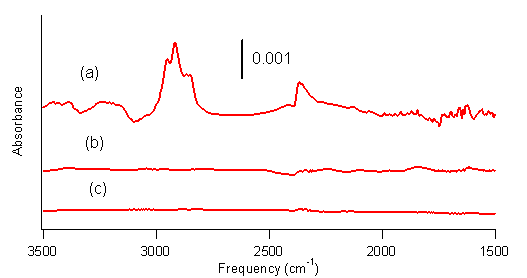Reports: B10
45004-B10 Investigating the Chemistry of Boranes with Single-Walled Carbon Nanotubes Using FTIR and Raman Spectroscopies
Work in the first year of the grant found evidence that borane complexes did not react with single-walled carbon nanotubes (SWCNTs) at 0°C or at room temperature. However, research in fall 2007 found that, when irradiated with light from a mercury lamp, SWCNTs do appear to react with borane-tetrahydrofuran. Continuation of this work in summer 2008 found that SWCNTs appear to react with borane-dimethyl sulfide but not with borane-triethylamine or borane-tert-butylamine when irradiated with light from a mercury lamp. These results suggest that the more reactive borane complexes will react with SWCNTs when irradiated with light from a mercury lamp, but the more stable borane complexes will not. The reaction appears to be a hydroboration reaction, which attaches a BH2 group and a H group to the nanotubes. Efforts to isolate these intermediates were difficult, presumably because of the reactivity of the BH2 group. Nonetheless, two of the student researchers, through careful experimentation, did reproducibly obtain infrared spectra of SWCNTs with peaks at 2300 cm1 and 2950 cm1 attributed to B-H stretches and C-H stretches, respectively, as shown in Figure 1.
Figure 1. FTIR spectrum of SWCNTs reacted with borane-tetrahydrofuran complex under irradiation from a mercury lamp. Peaks at 2300 cm1 are consistent with BH stretches, and peaks at 2950 cm1 are consistent with CH stretches.
Work in spring 2008 determined that the reaction is initiated by light of wavelength less than 300 nm. This suggests that the SWCNTs are absorbing the ultraviolet light to undergo a p→p * transition. This could interrupt the aromaticity of the nanotubes' structure, increasing their reactivity. Computational studies indicated that the hydroboration reaction is endoergonic, suggesting that it is likely not spontaneous without some energy input. Experiments with optical filters have yielded some evidence for the photochemical reaction mechanism.
Three optical filters were used. The first, U330, transmits light from the UV to the edge of the visible range, or from about 250 to 400 nm. The second, U360, transmits light from the mid-UV to the visible range, or from about 300 to 400 nm. The third, B440, transmits light from the near edge of the visible range to the middle of that range, or from about 380 to 500 nm. These three filters cover the UV to the visible in a nearly mutually exclusive manner, allowing us to ascertain if one particular wavelength region is responsible for exciting the reactants and leading to reaction. FTIR spectra of SWCNTs irradiated with light that passed through one of these three filters and reacted with borane-tetrahydrofuran are shown in Figure 2. Figure 2a shows SWCNTs from a reaction mixture irradiated with light that passed through U330. Figure 2b shows SWCNTs from a reaction mixture irradiated with light that passed through UG360. Figure 2c shows SWCNTs from a reaction mixture irradiated with light that passed through B440.
Figure 2. FTIR spectra of SWCNTs reacted with BH3THF for 6 h under mercury lamp irradiation with light passing through (a) filter U330 (b) filter U360 and (c) filter B440.
These results clearly indicate that light in the range of 250-300 nm is necessary to drive the hydroboration reaction. The Hg lamp has a major peak at 254 nm, which overlaps with the broad UV absorption of SWCNTs at lmax=260 nm. This strongly suggests that the photochemical hydroboration reaction proceeds through an electronic excitation of the SWCNTs. An SWCNT that undergoes a p→p * transition would be reactive toward nearby molecules, resulting in this case in a hydroboration reaction.
To verify that a hydroboration reaction had taken place, SWCNTs reacted with borane-tetrahydrofuran under ultraviolet irradiation were then reacted with a sodium hydroxide/hydrogen peroxide mixture. These conditions are those of a classic hydroboration-oxidation reaction, in which borane adds across a double bond to form BH2 and H groups, and the BH2 group is subsequently oxidized to OH. Infrared spectra of the SWCNTs subjected to these steps, such as the one shown in Figure 3, show numerous peaks that are consistent with our hypothesis: OH stretches at 3360 cm1, CH stretching peaks at 2900 cm1, CO stretches at 1090 and 1260 cm1, and a CH bend at 1400 cm1. This strongly suggests that the SWCNTs are undergoing a photo-initiated hydroboration/oxidation reaction.
Figure 3. FTIR spectrum of hydroboratedoxidized SWCNTs.
The Raman spectrum of the purified SWCNTs, shown in Figure 4a, shows the radial breathing band at ~250 cm1 and the G band at ~1580 cm1, both of which are characteristic of SWCNTs. The Raman spectrum of hydroborated-oxidized SWCNTs, Figure 4b, shows these features and an increase in the D band at ~1280 cm1, which indicates functionalization of the SWCNTs. The ratio of D band to G band peak areas of 0.15 is consistent with moderate functionalization of the SWCNTs.
Figure 4. Raman spectrum of hydroboratedoxidized SWCNTs.
This work is one of just a few reports of photochemical reactions involving SWCNTs. It is also, to our knowledge, the first report of the reaction of borane compounds with SWCNTs. Six undergraduate students contributed to this research, and it has recently been accepted for publication in the Journal of Physical Chemistry C. This brings the initial part of this research to a successful conclusion, while opening the door for the continued exploration of the reaction of boron-containing compounds with SWCNTs. This grant has allowed me to continue to develop as a researcher and has put my research program on solid footing. I am now able to attract about five undergraduate students per semester and two undergraduate students per summer to engage in research. This research has directly supported six undergraduate students and indirectly supported eight more. Many of these students presented posters on their research at regional or national conferences. Six of the students who worked on this research are co-authors on the recently accepted journal article. I thank the ACS PRF for their support to make this success possible.








